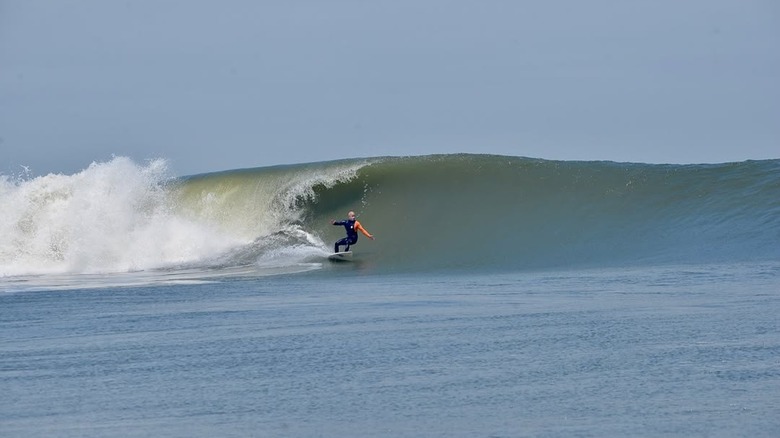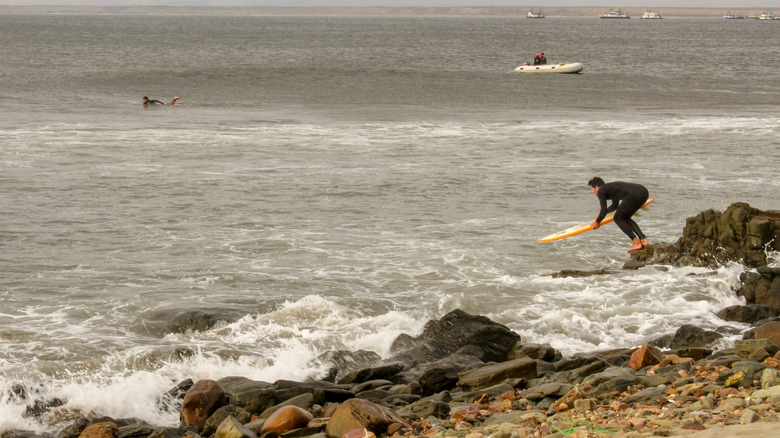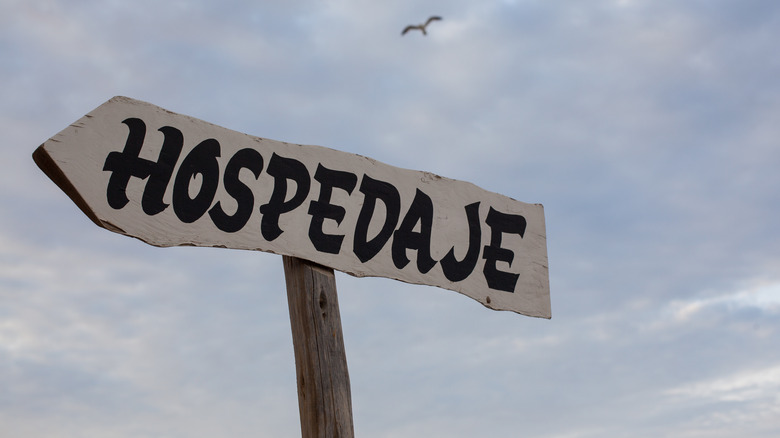Surfers Are Flocking To This Dreamy Country For The World's Longest Wave
The image of Machu Picchu and other under-the-radar ancient ruins may come to mind when you think of Peru, but a small fishing town on its north coast is gaining traction among the global surfing community. Travelers from all around the world come to Puerto Malabrigo, also known as Chicama, to experience riding a wave so long you can listen to a full song and not be done yet.
According to NASA, while it's difficult to know for sure, the swells at Chicama might be the longest left-hand waves in the world. For those unfamiliar, left-hand waves break to the left from the surfer's point of view while paddling out. That means the surfer's left side does most of the work as they carve through the water in a counter-clockwise motion.
Surfers spend around 7 seconds riding an average-sized wave break, but at Chicama, they can stay in one for 3 to 5 minutes as they stretch to over a mile. How is this possible? The wave comprises several sections — Malpaso, Keys, El Point, and El Hombre — that can connect during powerful swells that create an uninterrupted ride.
However, the waves at Chicama are not just for pros. Even beginners can get their start here thanks to the smooth shape of the waves. "Chicama's waves aren't just long. They are perfectly shaped. They couldn't break for as long as they do if they weren't," Peruvian surfer Gino "Chato" Guillen tells NBC News. "You don't need to surf the whole break to appreciate what's special about this place."
Surf is at the heart of Chicama's culture
Chicama is a humble fishing village, so it does not offer much in terms of amenities or tourist attractions. The main draw is the sea and, just as important, connecting with a community of passionate surfers, both local and visitors. It is a treat for those looking to reconnect with nature while being part of a like-minded group.
The waves are so crucial to local identity that in 2013, the Peruvian government passed groundbreaking legislation to protect them from development. This was a historical milestone, as it was the first legally protected wave in the world. Today, the Protected Waves Registry has over 40 Peruvian waves in its list. Naturally, locals expect tourists to treat their beaches with the same respect. This is why Chicama Boutique Hotel hands out free coffee to tourists in exchange for collecting plastic litter from the beach. Throughout the years, they have collected almost 6 tons of plastic from the shoreline.
Also, Peru may be internationally known for having safe, authentic Ayahuasca wellness retreats, but surfing wellness retreats are on the rise as well. Anyone who's ever surfed knows how restorative riding a wave can feel, so it's no surprise that Chicama is also a hub for international and local programs that mix surf and therapy. Plus, nonprofit organizations like Surf Cerrito strongly believe in the benefits of surf. It empowers local youths with surfing lessons and discussions about mental health and environmental sustainability.
Where to stay at Chicama, Peru
The standout lodging in the area is the Chicama Boutique Hotel. It offers ocean-view rooms, an infinity pool, a jacuzzi circuit, saunas, a gym, and a yoga studio. It also organizes fishing tours with local fishermen and cooking lessons, where tourists can learn how to make signature Peruvian seafood dishes. Just know it's the most expensive hotel in town, though. Prices range from $140 to $300 a night. And it's pet friendly! For budget-conscious travelers, there are modest hostels in the area. Los Burritos Hostal offers private rooms from $15, and an apartment on Airbnb averages $40 a night.
Chicama's stunning breaks are available year-round, but the best time to find large swells is from March through November. To get to Chicama, fly into the Trujillo International Airport and take the hour-and-a-half bus ride to reach the town, or hire a taxi for around $40. You can rent a surfboard in many of the local shops, but if you're planning to travel with yours, check out our best tips for traveling on a plane with sports equipment.
Finally, if you feel like taking a break from surfing sometime during your trip, take a fascinating historical excursion to the ancient ruins of Chan Chan, the largest pre-Columbian city in the Americas, which are located only about half an hour away by car.


